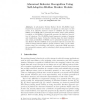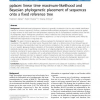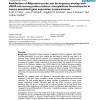402 search results - page 32 / 81 » Feature Generation for Sequence Categorization |
ICIAR
2009
Springer
14 years 16 days ago
2009
Springer
A self-adaptive Hidden Markov Model (SA-HMM) based framework is proposed for behavior recognition in this paper. In this model, if an unknown sequence cannot be classified into an...
ACCV
2009
Springer
14 years 2 months ago
2009
Springer
Abstract. This paper introduces a new model-based approach for simultaneously reconstructing 3D human motion and full-body skeletal size from a small set of 2D image features track...
BMCBI
2004
13 years 7 months ago
2004
Background: Multi-locus sequence typing (MLST) is a method of typing that facilitates the discrimination of microbial isolates by comparing the sequences of housekeeping gene frag...
BMCBI
2010
13 years 8 months ago
2010
Background: Likelihood-based phylogenetic inference is generally considered to be the most reliable classification method for unknown sequences. However, traditional likelihood-ba...
BMCBI
2005
13 years 7 months ago
2005
Background: Comparison of data produced on different microarray platforms often shows surprising discordance. It is not clear whether this discrepancy is caused by noisy data or b...



